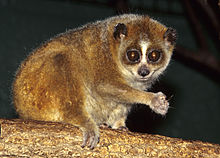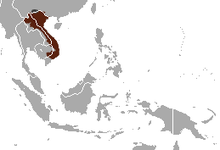- Pygmy slow loris
-
Pygmy slow loris[1] 
Conservation status Scientific classification Kingdom: Animalia Phylum: Chordata Class: Mammalia Order: Primates Family: Lorisidae Genus: Nycticebus Species: N. pygmaeus Binomial name Nycticebus pygmaeus
Bonhote, 1907
Pygmy Slow Loris range Synonyms - intermedius Dao Van Tien, 1960
See also: Conservation of slow lorisesThe pygmy slow loris (Nycticebus pygmaeus) is a rare species of loris found in the tropical dry forests of Vietnam, Laos, southern China, and east of the Mekong River in Cambodia. This primate is a nocturnal animal and will eat fruit, insects, small mammals and reptiles, flowers, tree gums, fungi, slugs and snails.[4]
It is arboreal, crawling on branches, unnoticed as it quietly moves through the thick leaves of the subtropics.[4]
Adults can grow to around 18–21cm long.[4]
It mates once every 12–18 months and will have 1–2 offspring after an average gestation period of 190 days. For the first few days, the young loris clings to belly of its mother. After 9 months the baby will be weaned.[4]
This loris was nearly wiped out during extensive burning, clearing and defoliating of forests in Vietnam during the Vietnam War.[4]
References
- ^ Groves, C. (2005). Wilson, D. E., & Reeder, D. M, eds. ed. Mammal Species of the World (3rd ed.). Baltimore: Johns Hopkins University Press. pp. 122-123. OCLC 62265494. ISBN 0-801-88221-4. http://www.bucknell.edu/msw3.
- ^ Streicher, U., Ngoc Thanh, V., Nadler, T., Timmins, R. J. & Nekaris, A. (2008). Nycticebus pygmaeus. In: IUCN 2008. IUCN Red List of Threatened Species. Downloaded on 1 January 2009.
- ^ UNEP-WCMC. "CITES species database: Nycticebus pygmaeus". UNEP-WCMC Species Database. http://www.unep-wcmc.org/isdb/CITES/Taxonomy/tax-species-result.cfm/isdb/CITES/Taxonomy/tax-species-result.cfm?Genus=Nycticebus&Species=pygmaeus&source=animals&displaylanguage=eng. Retrieved 3 February 2011.
- ^ a b c d e "Pygmy slow loris". Bristol Zoo Gardens. http://www.bristolzoo.org.uk/pygmy-slow-loris. Retrieved 2006-08-01.
Extant species of family Lorisidae Kingdom: Animalia · Phylum: Chordata · Class: Mammalia · Order: Primates · Suborder: Strepsirrhini Perodicticinae Lorisinae
(Lorises)Sunda slow loris (N. coucang) · Bengal slow loris (N. bengalensis) · pygmy slow loris (N. pygmaeus) · Javan slow loris (N. javanicus) · Bornean slow loris (N. menagensis)Category Categories:- IUCN Red List vulnerable species
- Mammals of Asia
- Fauna of Vietnam
- Lorises and galagos
- Venomous mammals
Wikimedia Foundation. 2010.


